1994 CADILLAC FLEETWOOD steering wheel
[x] Cancel search: steering wheelPage 47 of 398
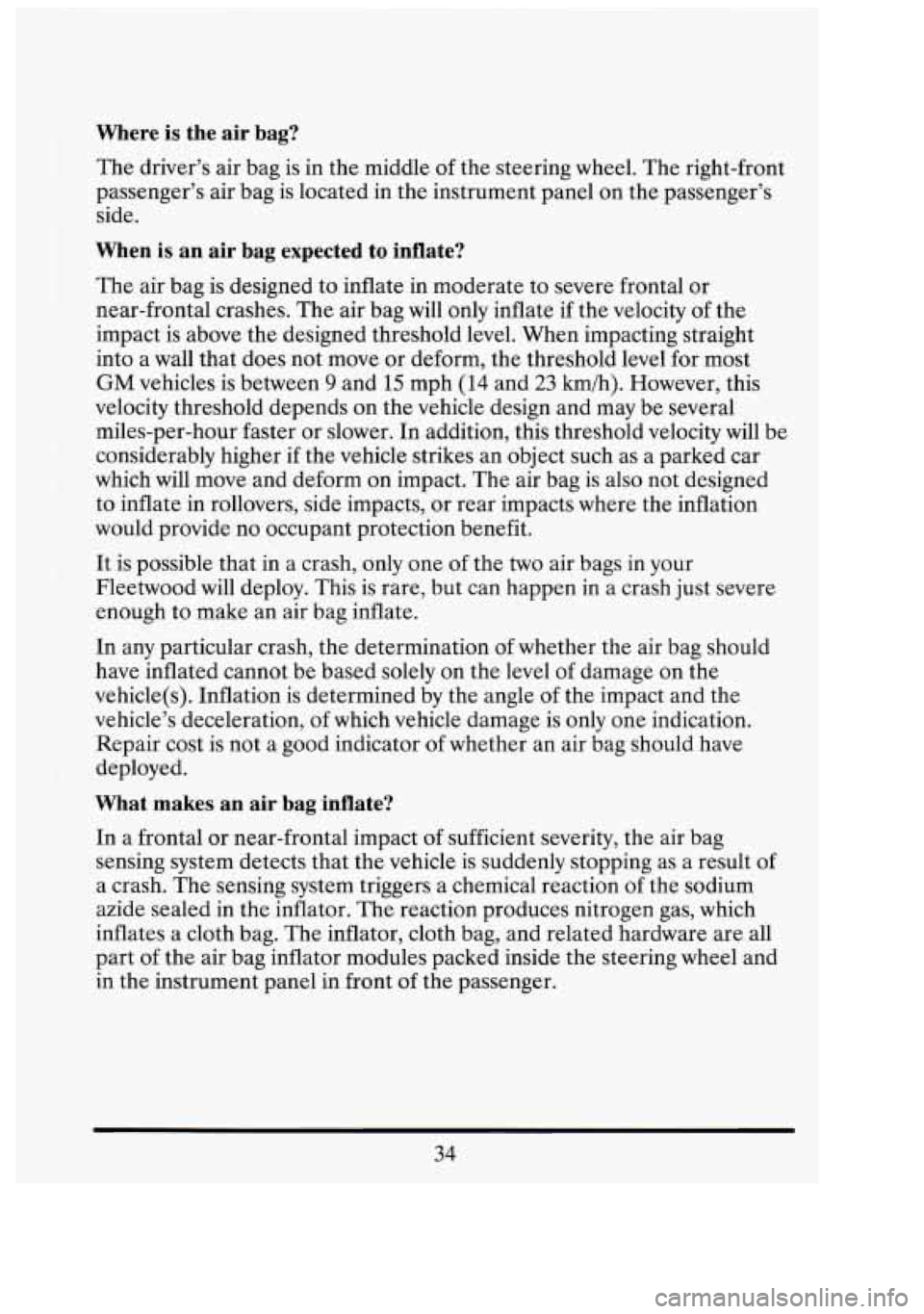
Where is the air bag?
t
The driver’s air bag is in the middle of the steering wheel. The right-front
passenger’s air bag is located in the instrument panel on the passenger’s
side.
When is an air bag expected to inflate?
The air bag is designed to inflate in moderate to severe frontal or
near-frontal crashes. The air bag will only inflate if the velocity
of the
impact is above the designed threshold level. When impacting straight
into a wall that does not move or deform, the threshold level for most
GM vehicles is between 9 and 15 mph (14 and 23 km/h). However, this
velocity threshold depends on the vehicle design and may be several
miles-per-hour faster or slower. In addition, this threshold velocity will be
considerably higher if the vehicle strikes an object such as a parked car
which will move and deform on impact. The air bag is also not designed
to inflate in rollovers, side impacts,
or rear impacts where the inflation
would provide no occupant protection benefit.
It is possible that in a crash, only one
of the two air bags in your
Fleetwood will deploy. This is rare, but can happen in a crash just severe
enough to make an air bag inflate.
In any particular crash, the determination of whether the air bag should
have inflated cannot be based solely on the level of damage on the
vehicle(s). Inflation is determined by the angle
of the impact and the
vehicle’s deceleration,
of which vehicle damage is only one indication.
Repair cost is not a good indicator
of whether an air bag should have
deployed.
What makes an air bag inflate?
In a frontal or near-frontal impact of sufficient severity, the air bag
sensing system detects that the vehicle is suddenly stopping as a result of
a crash. The sensing system triggers a chemical reaction of the sodium
azide sealed in the inflator. The reaction produces nitrogen gas, which
inflates
a cloth bag. The inflator, cloth bag, and related hardware are all
part of the air bag inflator modules packed inside the steering wheel and
in the instrument panel in front of the passenger.
34
al
fl
DI
Page 48 of 398
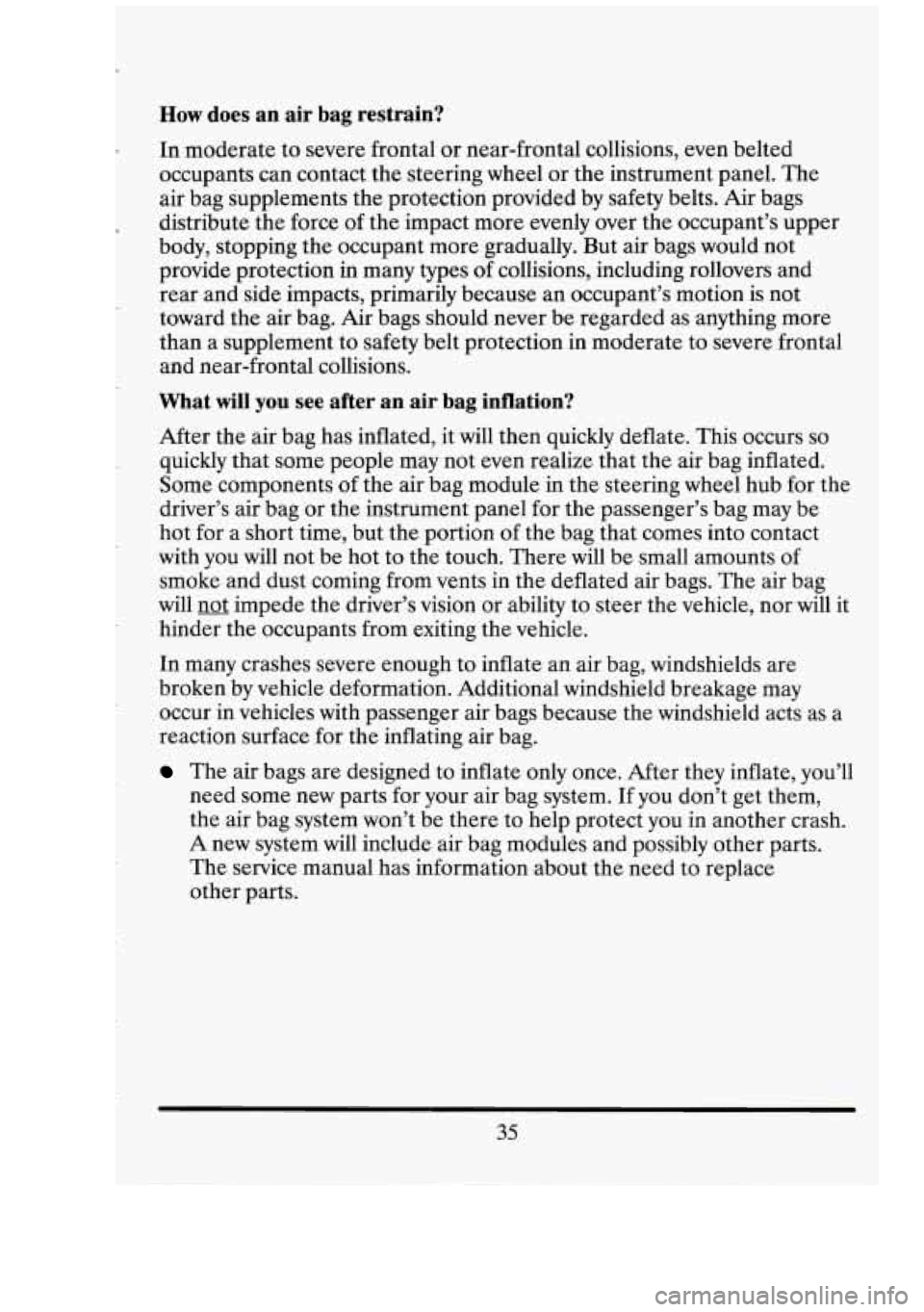
How does an air bag restrain?
In moderate to severe frontal or near-frontal collisions, even belted
occupants can contact the steering wheel or the instrument panel. The
air bag supplements the protection provided by safety belts. Air bags
distribute the force of the impact more evenly over the occupant’s upper
body, stopping the occupant more gradually. But air bags would not
provide protection in many types
of collisions, including rollovers and
rear and side impacts, primarily because an occupant’s motion
is not
toward the air bag. Air bags should never be regarded as anything more
than a supplement to safety belt protection in moderate to severe frontal
and near-frontal collisions.
What will you see after an air bag inflation?
After the air bag has inflated, it will then quickly deflate. This occurs so
quickly that some people may not even realize that the air bag inflated.
Some components of the air bag module in the steering wheel hub for the
driver’s air bag or the instrument panel for the passenger’s bag may be
hot for a short time, but the portion of the bag that comes into contact
with you will not be hot to the touch. There will be small amounts of
smoke and dust coming from vents in the deflated air bags. The air bag
will
not impede the driver’s vision or ability to steer the vehicle, nor will it
hinder the occupants from exiting the vehicle.
In many crashes severe enough to inflate an air bag, windshields are
broken by vehicle deformation. Additional windshield breakage may
occur in vehicles with passenger air bags because the windshield acts as a
reaction surface for the inflating air bag.
The air bags are designed to inflate only once. After they inflate, you’ll
need some new parts for your air bag system. If you don’t get them,
the air bag system won’t be there to help protect you in another crash.
A new system will include air bag modules and possibly other parts.
The service manual has information about the need to replace
other parts.
35
Page 49 of 398

Your vehicle is equipped with a diagnostic module, which records
information about the air bag system if the air bag deploys in a crash.
The module records information about the readiness of the system,
which sensors activated the deployment, and whether the driver’s
safety belt was in use.
Let only qualified technicians work on your air bag system. Improper
service can mean that your air bag system won’t work properly. See
your dealer for service.
NOTICE:
If you damage the cover for the driver‘s or the right-front\
passenger’s air bag, they may not work properly.
You may have
to replace the air bag
on the steering wheel or both the air bag
and the instrument panel for the passenger‘s air bag.
Do not
open or break the air bag covers.
Is the smokefiom an air bag inflation harmful?
The particles emitted during air bag inflation are not harmful to most
people. Some people with respiratory ailments may experience difficulty
breathing
if they stay in the vehicle with the windows closed after air bag
inflation.
So, if your air bag inflates, you and any passengers should exit
the vehicle if and when it is safe to do
so. If you or your passengers can’t
get out of the vehicle, try to get fresh air by opening a window, turning
on
the fan, or opening a door.
36
n
LA
r
LY
31
Jl
Page 94 of 398

THEFT
Vehicle theft is big business, especially in some cities. Although your
Cadillac has a number of theft deterrent features,
we know that nothing
we put on it can make it impossible to steal. However, there are ways you
can help.
Key in the ignition
If you walk away from your vehicle with the keys inside, it’s an easy target
for joy riders or professional thieves
-- so don’t do it.
When you park your Cadillac and open the driver’s door, you’ll hear a
chime reminding you to remove your key from the ignition and take it
with you. Always do this. Your steering wheel will be locked, and
so will
your ignition and transmission. And remember to lock the doors.
Parking at Night
Park in a lighted spot, close all windows and lock your vehicle. Remember
to keep your valuables out
of sight. Put them in a storage area, or take
them with you.
Parking Lots
If you park in a lot where someone will be watching your vehicle, it’s best
to lock it up and take your keys. But what if you have to leave your
ignition key? What if you have to leave something valuable in your
vehicle?
0 Put your valuables in a storage area, like your trunk or glove box.
Lock the glove box.
0 Lock all the doors except the driver’s.
Then take the door key with you.
81
Page 98 of 398
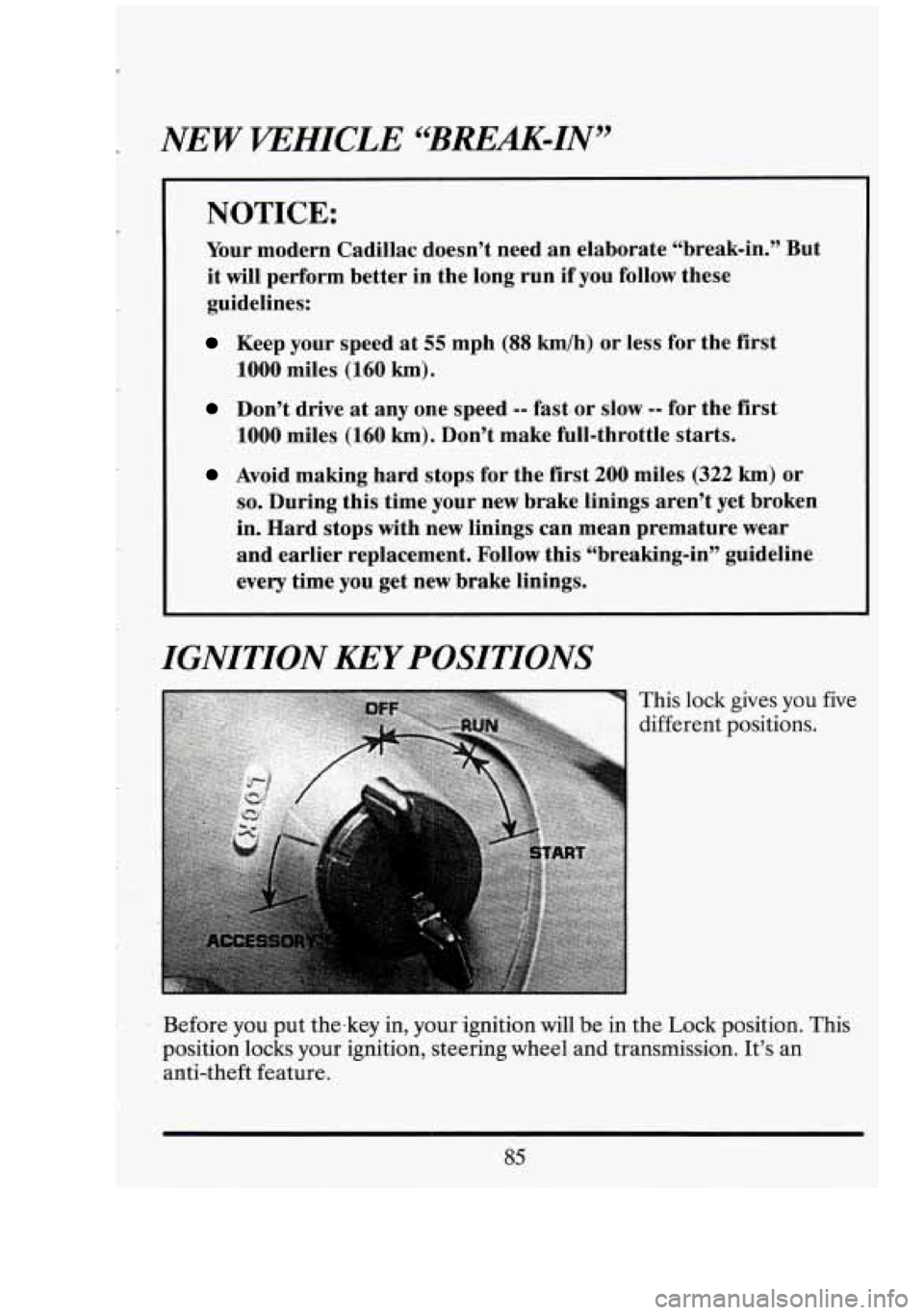
NOTICE:
Your modern Cadillac doesn’t need .an elaborate “break-in.” But
it will perform better in the long run if you follow these
guidelines:
Keep your speed at 55 mph (88 km/h) or less for the first
1000 miles (160 km).
Don’t drive at any one speed -- fast.or slow -- for the first
1000 miles (160 km). Don’t make full-throttle starts.
Avoid making hard stops for the first 200 miles (322 km) or
so. During this time your new brake linings aren’t yet broken
in. Hard stops with new linings can mean premature wear
and earlier replacement. Follow this “breaking-in’’ guideline
every time
you get new brake linings.
IGNITIQN KEY POSITIONS
This lock
different : gives you
positions. five
‘Before you put the-key in, your ignition will
be in the Lock position. This
position locks your ignition, steering wheel and transmission. It’s an
anti-:theft ,feature.
Page 99 of 398

I
The other positions let you perform these functions:
ACC: Accessory lets you use things like the radio and the windshield
wipers when the engine is
off. To get into “ACC”, push in the key and turn
it toward
you. Yoursteeringwheel will remain locked, just as it was
before you inserted the key.
OFF: This position lets you turn off the engine but still turn the steering
wheel. It doesn’t lock the steering wheel like “Lock.” Use “Off”
if you
must have your car in motion while the engine is
off (for example, if your
car is being pushed).
RUN This is the position for driving.
START This starts your engine.
NOTICE:
If your key seems stuck in “Lock” and you can’t turn it, be sure
it
is all the way in. If it is, then turn the steering wheel left and
right while. you turn the key hard. But turn the key only with
your hand. Using
a tool to force it could break the key or the
ignition switch.
If none of this works, then your vehicle needs
service.
STARTING YOUR ENGINE
Move your shift lever to “P” (Park) or “N” (Neutral). Your,,engine won’t
start in
any other position -- that’s a safety feature. To restart when you’re
already moving, use “N” (Neutral) only.
NOTICE:
Don’t try to shift to “P” (Park).. if your Cadillae is moving. If you
do, you could .damage the transmission. Shift to “P” (Park) only
when your vehicle
is stopped. ”. .
1
W I
D
I
I
-
Page 109 of 398
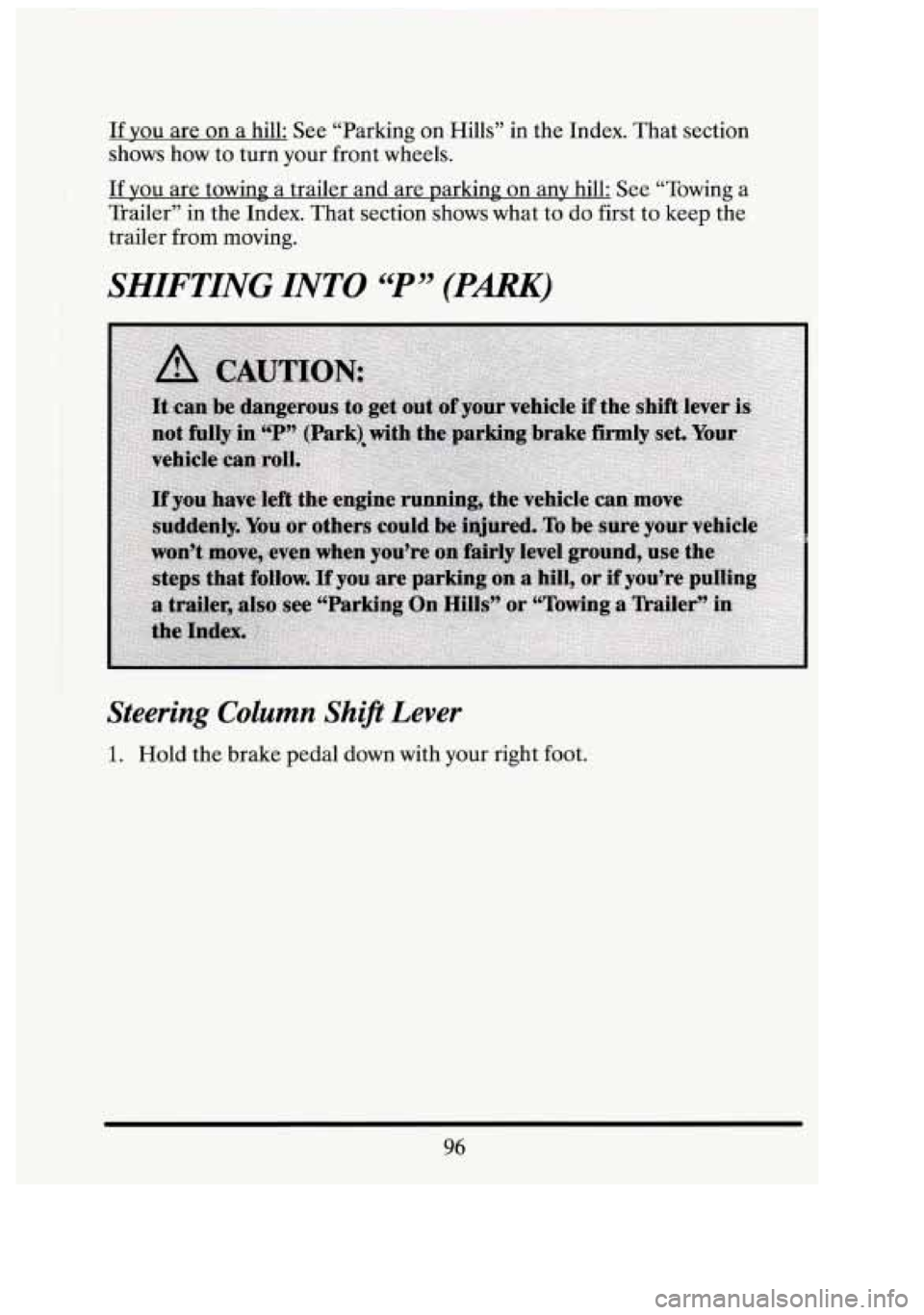
If you are on a hill: See “Parking on Hills” in the Index. That section
shows how to turn your front wheels.
If you are towing a trailer and are parking on any hill: See “Towing a
Trailer” in the Index. That section shows what to do first to keep the
trailer from moving.
SHIFTING INTO 44P” (PARK)
Steering Column Shift Lever
1. Hold the brake pedal down with your right foot.
E
1
n !fl
I
96
..
Page 115 of 398
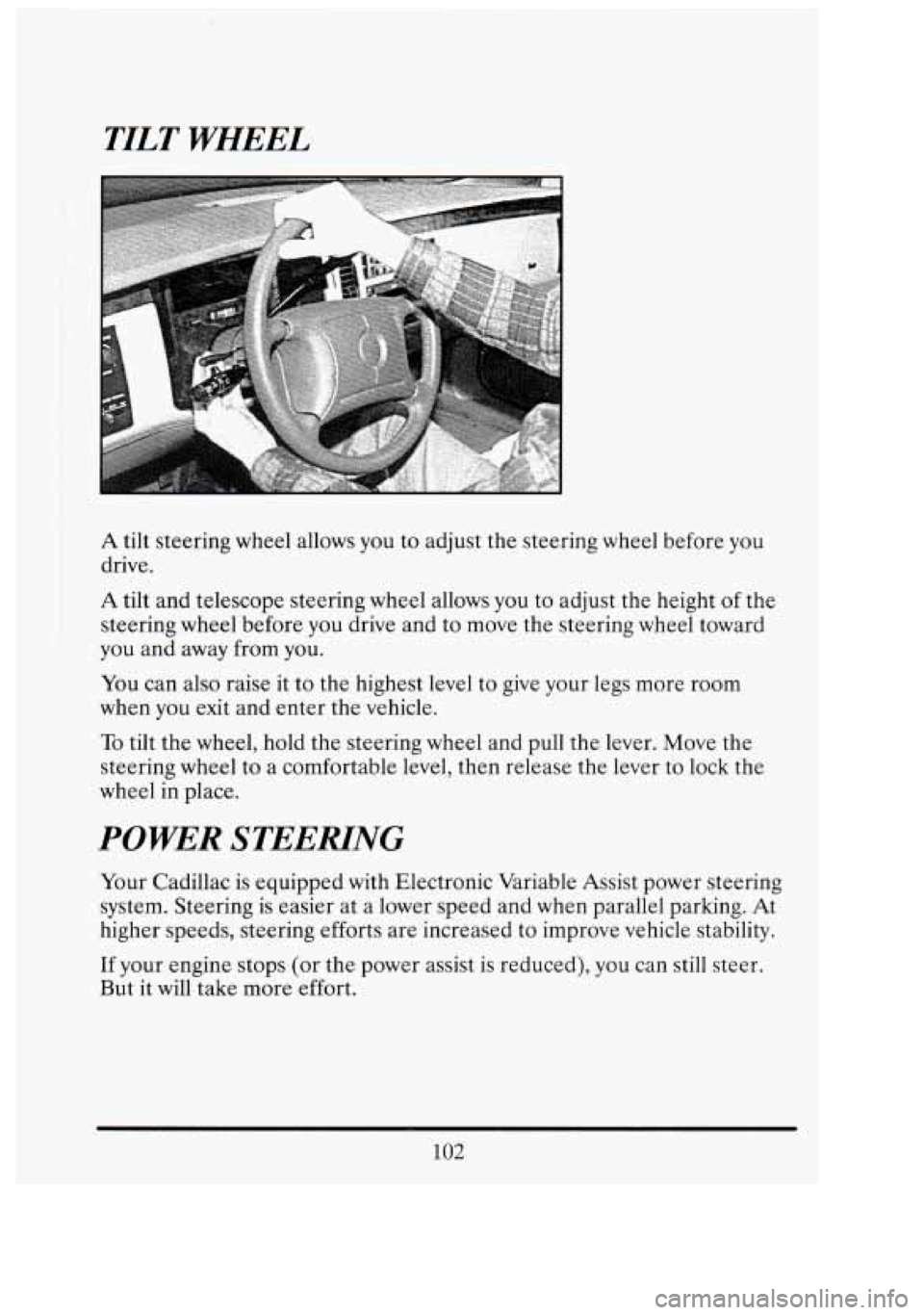
TILT WHEEL
A tilt steering wheel allows you to adjust the steering wheel before you
drive.
A tilt and telescope steering wheel allows you to adjust the height of the
steering wheel before you drive and to move the steering wheel toward
you and away
from you.
You can also raise it to the highest level to give your legs more room
when you exit and enter the vehicle.
To tilt the wheel, hold the steering wheel and pull the lever. Move the
steering wheel to a comfortable level, then release the lever
to lock the
wheel
in place.
POWER STEERLNG
Your Cadillac is equipped with Electronic Variable Assist power steering
system. Steering is easier at a lower speed and when parallel parking. At
higher speeds, steering efforts are increased to improve vehicle stability.
If your engine stops (or the power assist is reduced),
you can still steer.
But it will take more effort.
102
GI
nr